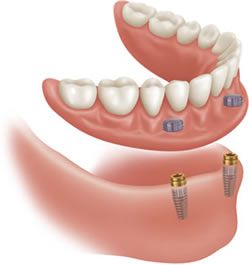Implant Supported Overdenture in Torrevieja Spain

Prostheses with Implant Support in Torrevieja
Table of Contents:
- Restoring Teeth with Implant Fixation in the Absence of Teeth.
- What Types of Implant-Supported Prostheses Are There?
- Removable Prostheses with Implant Fixation.
- Description of Removable Acrylic Prostheses. General Features.
- Non-Removable Constructions on Implants.
- Advantages of Non-Removable Prostheses.
- Important!
Restoring Teeth with Implant Fixation in the Absence of Teeth
Dental implants are the most modern and reliable technology for restoring lost teeth.
Restoring teeth on implants is done in two stages:
- Surgical
- Orthopedic
Surgical Stage - Implant Placement
The implant itself is an artificial titanium "root" of a tooth that is screwed into the bone. Typically, after implant placement, it is left in the bone for integration (healing) for about 3-6 months, during which time the patient goes without a tooth. After this period, the second stage of prosthetics is carried out. In some cases, prostheses can be installed on the day of implantation without waiting for several months. This decision is made by the surgeon during the intervention planning and depends on the initial condition of the bone tissue and gums. It is also important to consider that, besides implant placement, bone reconstruction or gum plastic surgery may be necessary.
Orthopedic Stage - Prosthesis Fabrication
To create a prosthesis (teeth that will be above the gum surface), preparatory procedures are necessary.
First, access to the implant is created through the gum, and then a gum former with a "button" is screwed onto it, rising above the gum. This is necessary for shaping the gum. The patient wears this former for about 2 weeks. Afterward, impressions/scans are taken, and the prosthesis is fabricated.
The gum-forming stage is excluded in cases of immediate prosthetics.
What Types of Implant-Supported Prostheses Are There?
Prostheses on implants come in several types depending on their fixation:
- Non-removable constructions on implants.
- Removable with implant fixation (on "buttons"-locators, on bars).
Removable Prostheses with Implant Fixation
The base of such prostheses is made of pink plastic that imitates the gums, onto which plastic teeth are installed. The prosthesis rests on the gums and is fixed with bars or locators, which snap on and off like buttons. Typically, 2-4 implants are used as support.
Description of Removable Acrylic Prostheses. General Features:
- Quick fabrication.
- Easy installation.
- Prostheses need to be cleaned after each meal, brushed at night, and cleaned with special cleaning agents once a week.
- Over time, the plastic becomes porous, accumulates plaque, changes color, and the artificial teeth wear out.
- Requires more frequent adjustments, re-basing, or replacement compared to non-removable prostheses (because plastic is less durable and wears out faster than ceramics).
- Periodic replacement of locator button parts may be necessary.
- Difficulty in adaptation, increased salivation, possible nausea, and speech problems.
- The prosthesis is clearly felt as a foreign object.
- Even distribution of chewing pressure across the entire jaw surface.
- Easy repair: it can be easily fixed in case of damage.
- Acrylic plastic may cause allergies. In such cases, a special hypoallergenic plastic can be used.
- May irritate the gums.
- Good fixation due to implants, compared to full removable prostheses without implants.
The most important difference from full removable prostheses without implant support is the convenience provided by the reliable fixation in the oral cavity. Patients can comfortably chew and speak without worrying that the prosthesis will move or fall out at an inconvenient moment.
Non-Removable Constructions on Implants
These are prostheses that are screwed onto implants with special screws. This is the best option for rehabilitation in the complete absence of teeth.
Advantages of Non-Removable Prostheses:
- Excellent stability in the mouth.
- No need to remove the prosthesis daily for cleaning.
- No discomfort, as the prosthesis does not rub against the gums or cover the palate.
- Convenient to use, as there is no mobility - comfortable for speaking, eating, etc.
- Lightweight and elegant constructions: the prosthesis is significantly less bulky than a regular removable one.
- If necessary (in case of breakage or implant rejection), it can be easily removed at the clinic by unscrewing the screws.
IMPORTANT!!! Very often, a temporary prosthesis is first fabricated, followed by a permanent one. This is due to the fact that when teeth are lost, bone atrophy occurs - a decrease in bone tissue in the jaws, and after implantation and prosthetics, this process continues ("gum recession"). It takes some time for the healing processes to occur after implantation and for the formation of the prosthetic bed. Temporary prostheses are made of plastic. Permanent ones are made of metal plastics, metal ceramics, zirconia dioxide with ceramic veneer, PEEK with composite veneer.
In conclusion, implant-supported prostheses offer an excellent opportunity to restore lost teeth. Regardless of the type of prosthesis chosen, it is essential to discuss all the details with a qualified specialist and follow care recommendations. By making the right choice, you can enjoy confidence and comfort in conversation and while eating.
Contact Information:
| Torrevieja, Pasaje Pais Vasco, edificio 1 local 4 | |
| +(34) 638 893 141 | |
| +(34) 638 893 141 | |
| apdenta@gmail.com | |
| Working hours: Mon - Fri: from 10:00 to 20:00 |


